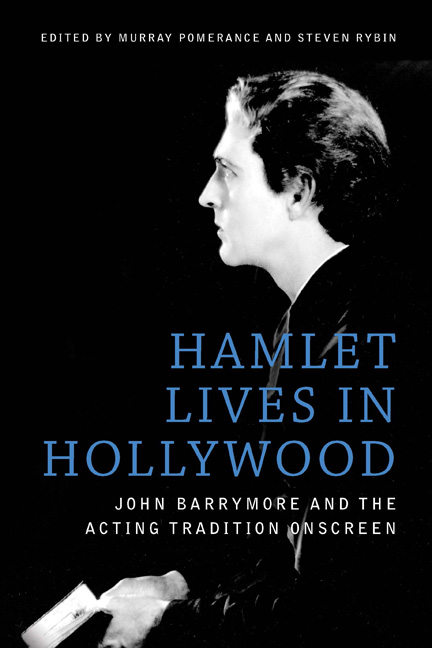Book contents
- Frontmatter
- Contents
- List of Figures
- The Contributors
- Acknowledgments
- Introduction
- 1 The Pre-Bard Stage Career of John Barrymore
- 2 Dangerously Modern: Shakespeare, Voice, and the “New Psychology” in John Barrymore's “Unstable” Characters
- 3 The Curious Case of Sherlock Holmes
- 4 John Barrymore's Introspective Performance in Beau Brummel
- 5 “Keep Back your Pity”: The Wounded Barrymore of The Sea Beast and Moby Dick
- 6 From Rome to Berlin: Barrymore as Romantic Lover
- 7 The Power of Stillness: John Barrymore's Performance in Svengali
- 8 Prospero Unbound: John Barrymore's Theatrical Transformations of Cinema Reality
- 9 A Star is Dead: Barrymore's Anti-Christian Metaperformance
- 10 Handling Time: The Passing of Tradition in A Bill of Divorcement
- 11 John Barrymore's Sparkling Topaze
- 12 “Planes, Motors, Schedules”: Night Flight and the Modernity of John Barrymore
- 13 Barrymore and the Scene of Acting: Gesture, Speech, and the Repression of Cinematic Performance
- 14 “I Never Thought I Should Sink So Low as to Become an Actor”: John Barrymore in Twentieth Century
- 15 Barrymore Does Barrymore: The Performing Self Triumphant in The Great Profile
- Works Cited
- Index
7 - The Power of Stillness: John Barrymore's Performance in Svengali
Published online by Cambridge University Press: 23 June 2018
- Frontmatter
- Contents
- List of Figures
- The Contributors
- Acknowledgments
- Introduction
- 1 The Pre-Bard Stage Career of John Barrymore
- 2 Dangerously Modern: Shakespeare, Voice, and the “New Psychology” in John Barrymore's “Unstable” Characters
- 3 The Curious Case of Sherlock Holmes
- 4 John Barrymore's Introspective Performance in Beau Brummel
- 5 “Keep Back your Pity”: The Wounded Barrymore of The Sea Beast and Moby Dick
- 6 From Rome to Berlin: Barrymore as Romantic Lover
- 7 The Power of Stillness: John Barrymore's Performance in Svengali
- 8 Prospero Unbound: John Barrymore's Theatrical Transformations of Cinema Reality
- 9 A Star is Dead: Barrymore's Anti-Christian Metaperformance
- 10 Handling Time: The Passing of Tradition in A Bill of Divorcement
- 11 John Barrymore's Sparkling Topaze
- 12 “Planes, Motors, Schedules”: Night Flight and the Modernity of John Barrymore
- 13 Barrymore and the Scene of Acting: Gesture, Speech, and the Repression of Cinematic Performance
- 14 “I Never Thought I Should Sink So Low as to Become an Actor”: John Barrymore in Twentieth Century
- 15 Barrymore Does Barrymore: The Performing Self Triumphant in The Great Profile
- Works Cited
- Index
Summary
Expert actors masterfully control their performances throughout their diverse roles, and John Barrymore proves equal to the multifaceted demands on the title character in Svengali (1931). With art direction strongly influenced by German expressionism, set against a backdrop of limited locations, Barrymore effectively guides and anchors the film through a commanding presentation of highly stylized, dramatic choices. With what appears to be minimal effort, Barrymore's restrained physical movements and modulated verbal delivery dominate the flurry of activity and concern swirling around his sinister Svengali. In effect, in director Archie Mayo's version of George du Maurier's novel, throughout Svengali's hypnotic manipulation of the chanteuse Trilby, Barrymore relies on limited verbal and constrained nonverbal choices to wield his devastating power.
Svengali (John Barrymore) tells the story of a supernaturally powerful voice teacher and pianist who hypnotizes women in person and controls them from afar. He carries on an affair with Honori (Carmel Myers) who, leaving her husband and his wealth, is driven to suicide by Svengali. He falls in love with, and dominates, a model, Trilby (Marian Marsh). She and artist Billee (Bramwell Fletcher) plan on marrying but Svengali, exercising hypnotic control over Trilby, whisks her away to tour European concert halls after deceiving Billee into thinking she has killed herself. Billee, discovering that Trilby is alive, pursues them to Cairo. During a concert there, Svengali slumps at the podium, his life force exhausted, praying for Trilby's love. She faints, whispers Svengali's name and, in Billee's arms, dies moments before a happy Svengali also expires.
Critics at the time and in the decades since have appreciated Barrymore's presentation of this devious, destructive character. Praising Barrymore'sperformance, Mordaunt Hall writes, “This production, which bears the title of Svengali, may have lost some of the romantic charm of the author's tale, but it compensates for this by Mr. Barrymore's imaginative and forceful portrayal, and also by Archie Mayo's knowledgeable supervision of the camera work.” Hall adds, “Mr. Barrymore's fine performance … surpasses anything he has done for the screen, including his masterful acting in the motion pictures of Stevenson's Dr. Jekyll and Mr. Hyde and Clyde Fitch's Beau Brummell” (“A Lesson in Golf. A Fashionable Rogue,” New York Times [May 1, 1931], 34, online at nytimes.com).
- Type
- Chapter
- Information
- Hamlet Lives in HollywoodJohn Barrymore and the Acting Tradition Onscreen, pp. 85 - 97Publisher: Edinburgh University PressPrint publication year: 2017

